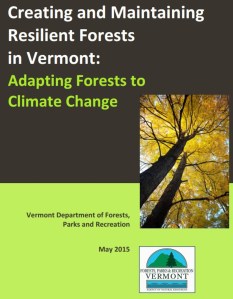 [T]he state of Vermont is helping landowners prepare for the impact of climate change on forests.
[T]he state of Vermont is helping landowners prepare for the impact of climate change on forests.
The Department of Forests, Parks and Recreation has released a new guidebook on forest management, titled “Creating and Maintaining Resilient Forests in Vermont: Adapting Forests to Climate Change.” The guidelines supplement current forest management planning and practices with adaptation strategies that could help protect forests from climate change related weather trends and projections.
The department is also updating the state’s Forest Action Plan, which will be released in September 2015.
Immediate risks to forests due to climate change are increases in chance of fire and changes in freeze cycles that could disrupt regular cone production, according to the guidebook.
Michael Snyder, commissioner of the Department of Forests, Parks and Recreation, says the guidebook is the first of its kind.
“In order to adapt to changes and conditions you have to pay attention and that’s really the main message of this whole work is — acknowledging that if you want to get it right you have to pay attention and it’s changing and we think having a mixed portfolio of options is the strongest way to be in a changing climate situation,” Snyder said.
The authors of the guidebook are part of the Adaptive Silviculture Work Group which includes foresters from different Vermont counties, and several representatives from the department — Sandra Wilmot, lead author of the report and the forest health specialist and climate change coordinator, and Jeffrey Briggs, project forester.
“This was prepared by our staff internally with no appropriation,” Snyder said. “They were a really good team of people that were very knowledgeable and very dedicated to forest health and sustainability and this is the product of their work. I hope people appreciate it.”
Wilmot said the report took several years for the work group to create and will have different outcomes for different people.
“It was a necessary exercise for us to think about how climate change fits into our forest management,” Wilmot said.
Wilmot said that there’s a lot of uncertainty when it comes to forest management and adapting to climate change. The guidebook is sort of like an insurance policy in that they don’t always know what the risk is but they can prepare for it by planning and researching these types of documents and strategies, she said.
“I think some of the extreme weather events that we see are unpredicted and we could always do more to reduce the risk,” Wilmot said.
Trees are unpredictable, but they have a lot of “tricks up their sleeves” for surviving in the woods decade after decade, Snyder said. This is because trees have been around a long time and they’re built to deal with change; they can’t go to Florida in the winter, they have to stay where they are, he said.

Foresters will have to become responsible for understanding climate trends, impacts to forest ecosystems, and the adaptability of forest species, according to the guidebook.
“For some of the people this will be an eye-opener because they really haven’t incorporated some of these strategies into their management,” she said.
The guide includes strategies that maximize storage of carbon in forests, ways to limit impacts of increased water-flow, and requirements for successful forest regeneration, according to the June 2 news release.
